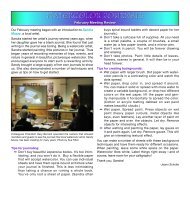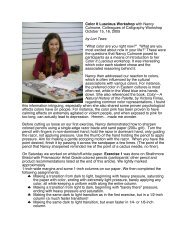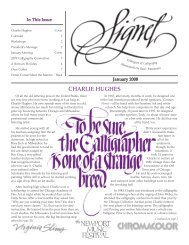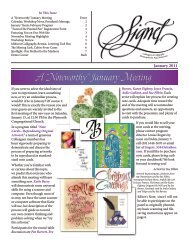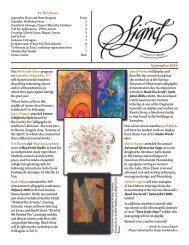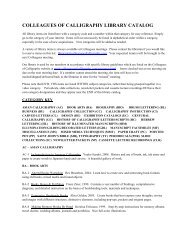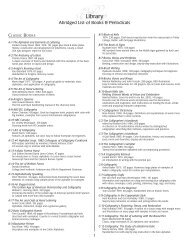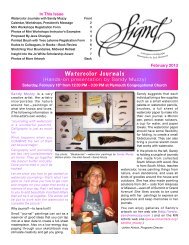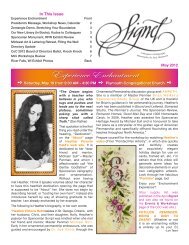making it yours: copying a manuscript alphabet - The Colleagues of ...
making it yours: copying a manuscript alphabet - The Colleagues of ...
making it yours: copying a manuscript alphabet - The Colleagues of ...
You also want an ePaper? Increase the reach of your titles
YUMPU automatically turns print PDFs into web optimized ePapers that Google loves.
MARCH MEETING Continued from page 3<br />
Insular Minuscules<br />
Kris MacDonald<br />
What is that lettering running between the lines <strong>of</strong> half-unicial in the Lindesfarne<br />
Gospels? <strong>The</strong>re seem to be many overlooked <strong>alphabet</strong>s and I thought these Insular<br />
Minuscules would be something new to use for warming up my lettering. How do you<br />
make these letters, what is going on here? Working from exemplars from two standard<br />
lettering books, we will study together, learning to really look at what's happening while<br />
trying to duplicate <strong>it</strong>. Perhaps you can enlighten me w<strong>it</strong>h your discoveries and questions.<br />
This <strong>alphabet</strong> does not have a contempory application, but <strong>it</strong> is the discipline <strong>of</strong> learning<br />
to look and copy accurately that's important.. It can apply to all <strong>of</strong> your practice.<br />
Supplies: Slant board, one color <strong>of</strong> gouache or ink, medium size nibs, paper to wr<strong>it</strong>e on—<br />
layout or graph, T-square, two colored pencils.<br />
DON’T FORGET<br />
Celtic Knotted Borders<br />
Gary Feyen<br />
Learn the “foundation”knot as I learned <strong>it</strong> from Aiden Meehan. <strong>The</strong> foundation<br />
knot and all <strong>it</strong>’s many variations are the key to drawing knot borders, pla<strong>it</strong>s or<br />
other <strong>it</strong>ems such as a celtic cross. We will do all three in this class. Even if you<br />
never draw a serious piece <strong>of</strong> knotwork, these are great doodles.<br />
Supplies: Pencil, eraser, ink, pointed pen, small pointed brush, ruler, smooth<br />
wh<strong>it</strong>e paper, marker – pointed or chisel 2mm/medium.<br />
TO SEND IN YOUR<br />
REGISTRATION . . .<br />
Characters on Canvas<br />
Ardie Gallant<br />
You’ve lettered on different kinds <strong>of</strong> paper, now try fabrics! We’ll explore the similar<strong>it</strong>ies<br />
and differences <strong>of</strong> the surfaces, possible backgrounds, tools to use, and how paints<br />
and inks relate to the fabric. Be adventuresome and you can take a small completed<br />
wall-hanging home w<strong>it</strong>h you! Fabrics, hangers and lots <strong>of</strong> extras provided.<br />
Supplies: Bring your favor<strong>it</strong>e tools, inks, paints and a short quote.<br />
Materials Fee: $3.00 payable to teacher.<br />
THE EARLIER<br />
THE BETTER!<br />
A Basket <strong>of</strong> Flower Techniques<br />
Joann Schulte<br />
We will examine the different shapes that make up flowers and practice w<strong>it</strong>h a<br />
variety <strong>of</strong> tools to get different effects.<br />
Supply List: Paint—watercolor and/or gouache and small palette; Brushes— flat<br />
chisel-edged and round, in different sizes; Angle and Filbert, if you have them;<br />
practice paper that will accept watercolor and some good paper, scraps are good;<br />
broad-edge pens, pointed pen such as the Pigma micron pens, pencil/eraser;<br />
water jar, paper towerls or rags. Materials Fee: $1.00 for each color copy you<br />
choose to buy.<br />
4<br />
Signet February 2008



